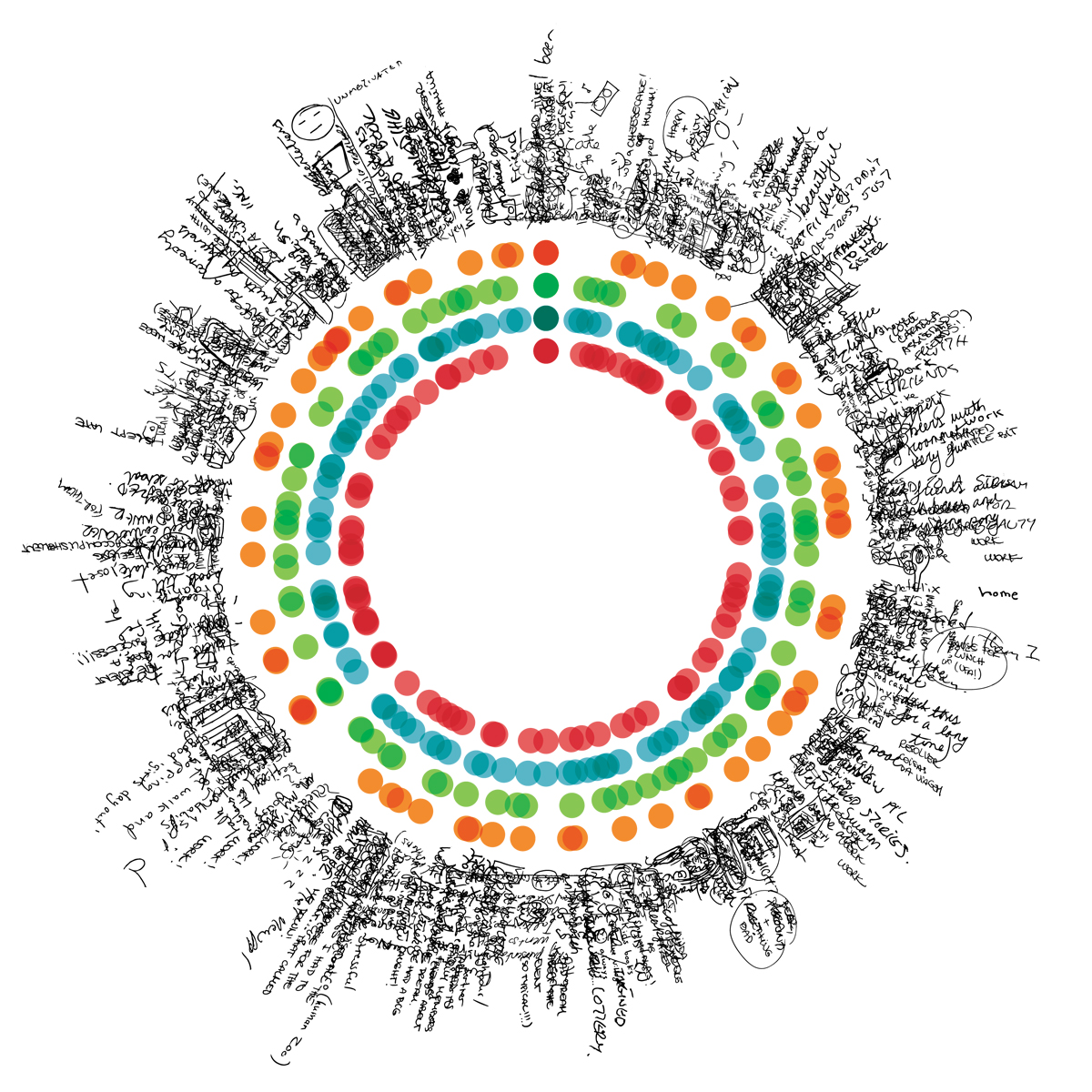Designing Mindful Reflection Practices
Can the act of reflecting on our daily experiences make us more self-aware and mindful of the moment? Over the course of my Masters of Design research, I have worked on the design of artefacts and subjective data visualizations as a way of representing individuals’ life stories.
The Journal Sculpture, and the Lifetime Scroll artefacts, as well as the Heart and Sapwood Visualizations, and the Lifetime Visualizations seen in this section are parts of the participatory design research analysis and the explorations through the act of designing.
These artefacts and data visualizations cannot be seen as “utilitarian solutions,” but as “holistic expressions of human meaning in a continually evolving field of understanding”—The Spirit of Design, Stuart Walker, 2011. They are representations of the continuous iterations we make on our own life.
JOURNAL SCULPTURE ARTEFACT
The Journal Sculpture artefact is made of several daily stories as well as of my own reflections on them. Its continuous and evolving aspects are now part of an aggregated structure in which every new loop can be seen as a new iteration over specific moments and different aspects of our lives. Its continuous revolution, suggested by this spiral form, allows the stories to be revisited, reconsidered, and evolve through incremental layers of knowledge.
LIFETIME SCROLL ARTEFACT
Everyday life stories can ground human experiences in a continuous and evolving learning structure. With this in mind, how can we mindfully connect with different aspects of our everyday experiences? Would journalling our feelings, perceptions, intentions and the actions we take in life make us more aware of the things we experience today?
Lifetime Scroll was meant to create introspective moments while unwinding through past experiences, which could reveal a trajectory full of choices, decisions and learnings. With this artefact, whenever a new story needed to be written, we should jump to the most recent moment lived, and incorporate it to the end of this thread.
HEART AND SAPWOOD VISUALIZATIONS
Following the Journal Sculpture and Lifetime Scroll artefacts, I designed a set of visualizations that rely not only on lines of text and images to allow a person to recall life stories and interactions. These visualizations can also be seen as an invitation to question how we situate the present moment in context of our life experiences, and to envision new stories to come.
Heart and Sapwood Visualization: holistic view of different lifetime experiences.
Segments of the continuously growing Heart and Sapwood Visualizations: for each segment, a life story.
These spiral visualizations represents life experiences based on analogy made with the ring formations seen on a tree log. The heartwood—or the inner part of the log—represents the early experiences we have in life: initial steps, relationships, childhood, and adolescence. The sapwood—formed by those outer rings—represents our most recent experiences. The sapwood is constantly on progress, interacting with the outer world at the same time it is in contact with our core, inner knowledge.
LIFETIME VISUALIZATIONS
What are the implications of a simultaneous micro and macro visualizations of our own life experiences? Would this type of holistic visualization challenge us to put our current moment into perspective? In this experimental project, I designed a set of visualizations suggesting that by looking back to our lifetime stories we create moments of introspection.
The abstraction of memories enables individuals to navigate from micro and punctual moments, to macro perspectives that show a broad view of life experiences. Each cross-section represents a period of time that carries specific stories categorized by emotional-, mental-, physical- and social- related experiences.
The emotional, mental, physical and social categories shown on these visualizations can trigger possible themes to reflect on, but can also constrain individuals’ actions, thoughts and beliefs into simplistic labels of abstractions, into conceptual ideas. One can consciously state that his or her daily actions evoked a more “mental” than “social” experience, while others could see the act of labeling our experiences as simplistic, leading people to mindlessly associate these categories to specific events in their lives.
THEORETICAL OUTCOME
As an outcome of this research process, I identified a framework for designing and creating reflection practices through how we perceive, express and contemplate our everyday lives. The Framework for Creating Mindful Reflection Practices suggests that we can perceive how we contemplate ourselves and our surroundings as opportunities for growth; we can express our perceptions, learnings and behaviours in a way that also manifests our cultural and individual values; we can contemplate what matters to us and our communities through the expression of our actions and decisions.
By committing to this triad—Perceive, Express, and Contemplate—, we create a cycle for developing resilience based on how we perceive ourselves in the context of the moment, how we express these perceptions, and how these two actions affect the way we contemplate and experience our lives.
Research through design
Human-centred design
Subjective data visualization
Everyday life experiences
/ Design methodology
/ Concept design
/ Artefact design
/ Information design
Project created as part of my thesis for the Master of Design program at Emily Carr University of Art + Design, 2017
This project was supported by the Canadian Institutes of Health Research, under the Canada Graduate Scholarships-Master’s Program (CGS-M), 2016.









